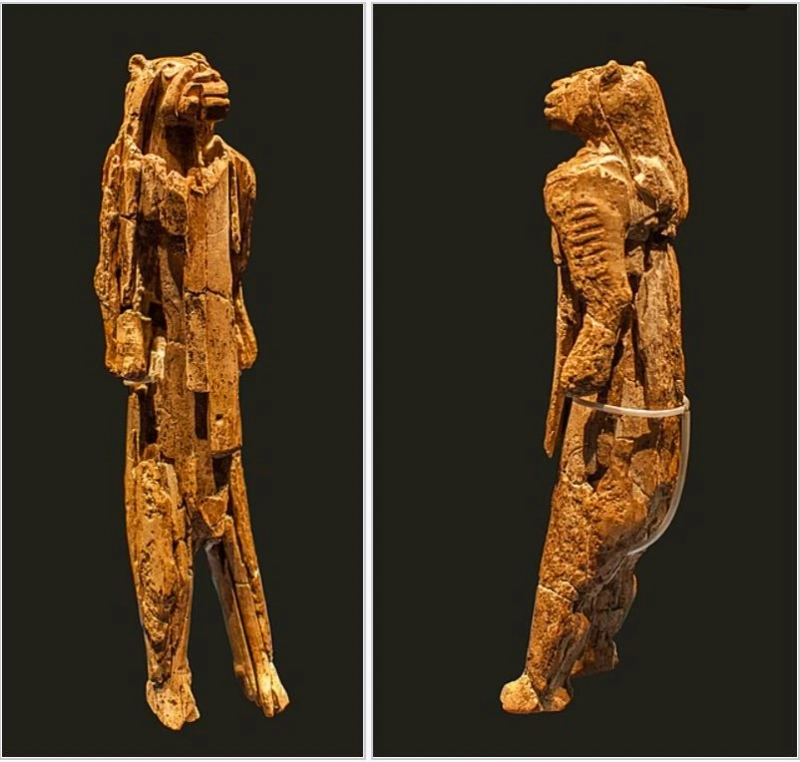The Lion Man, also known as the Löwenmensch, is widely considered the oldest statue in the world. This remarkable artifact dates back approximately 40,000 years and offers a profound glimpse into the artistic and cultural practices of our prehistoric ancestors. Discovered in the Hohlenstein-Stadel cave in Germany, the Lion Man is not only a testament to early human creativity but also a significant piece of the puzzle in understanding the development of symbolic thought and religious practices.
Discovery and Characteristics
The Lion Man statue was discovered in 1939 by archaeologist Robert Wetzel in the Hohlenstein-Stadel cave in the Swabian Alps of Germany. However, the significance of the find was not fully realized until later, when additional excavations and studies were conducted in the 1960s and 1980s. The statue was painstakingly reconstructed from over 200 fragments, revealing a figure standing about 31 centimeters (12 inches) tall, carved from mammoth ivory.
The statue depicts a humanoid figure with the head of a lion, combining human and animal traits in a way that suggests early forms of mythological or religious symbolism. The details of the carving, such as the intricate depiction of the lion’s features and the humanoid body, indicate a high level of skill and artistic sophistication.
Age and Significance
Radiocarbon dating of the surrounding sediment layers suggests that the Lion Man was created during the Upper Paleolithic period, around 40,000 years ago. This places it firmly within the Aurignacian culture, which is associated with the earliest presence of modern humans (Homo sapiens) in Europe.
The significance of the Lion Man extends beyond its age. As the oldest known statue, it provides critical insights into the cognitive and cultural evolution of early humans. The creation of such an intricate and symbolic object indicates that the people of this period had developed complex abstract thinking, the ability to plan and execute detailed artistic projects, and possibly, a form of spiritual or religious belief.
Artistic and Cultural Context
The Lion Man’s hybrid form—part human, part lion—suggests a rich symbolic or mythological significance. It is likely that this statue played a role in the spiritual or religious life of its creators. The combination of human and animal features is a recurring theme in many mythologies and suggests early humans’ attempts to understand and represent the world around them.
In the broader context of Upper Paleolithic art, the Lion Man stands out for its size and detail. While cave paintings and smaller figurines from this period are relatively common, the Lion Man’s intricate craftsmanship and the effort required to carve it from a single piece of mammoth ivory make it unique. It is part of a wider tradition of prehistoric art in the Swabian Alps region, which includes other carved figurines and flutes made from bird bones and mammoth ivory.
The Process of Creation
Creating the Lion Man would have been a labor-intensive process, requiring significant time, skill, and resources. The carver used stone tools to shape the mammoth ivory, which involved precise and careful work to avoid breaking the material. This process underscores the value placed on the statue, suggesting it held significant importance for the people who made it.
The fact that such a statue was created also implies the presence of a stable social structure that could support specialized artistic activities. The carver would have needed both the time and the means to engage in this complex task, suggesting a community that could afford to invest in artistic and possibly spiritual endeavors.
Modern Interpretation and Display
Today, the Lion Man is housed in the Ulm Museum in Germany, where it continues to attract significant interest from archaeologists, historians, and the public. The statue not only represents an extraordinary achievement of prehistoric art but also serves as a focal point for understanding the cognitive and cultural development of early humans.
Modern interpretations of the Lion Man often focus on its symbolic aspects, exploring what it might tell us about the beliefs and values of Upper Paleolithic people. Some researchers speculate that it could represent a deity, a mythological figure, or a shamanic entity, reflecting early forms of animism or totemism.
Conclusion
The Lion Man of Hohlenstein-Stadel stands as the oldest known statue in the world, offering invaluable insights into the lives and minds of our prehistoric ancestors. Its creation around 40,000 years ago marks a significant point in human history, reflecting the development of artistic skills, symbolic thinking, and possibly early spiritual beliefs. As a remarkable piece of prehistoric art, the Lion Man continues to inspire and intrigue, providing a tangible connection to our distant past and the enduring human capacity for creativity and expression.


